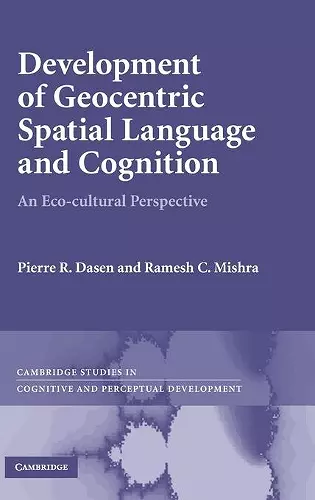Development of Geocentric Spatial Language and Cognition
An Eco-cultural Perspective
Pierre R Dasen author Ramesh C Mishra author
Format:Hardback
Publisher:Cambridge University Press
Published:12th Aug '10
Currently unavailable, and unfortunately no date known when it will be back
This hardback is available in another edition too:
- Paperback£36.99(9781107412484)

Investigates the acquisition and use of geocentric spatial language for children in Bali, India, Nepal, and Switzerland.
When talking about the location of objects inside a room, we can use small-scale egocentric directions (right and left) or large-scale geocentric ones (North, South, East and West). This book explores children's acquisition and use of spatial frames of reference in different cultural contexts, including Bali, India, Nepal, and Switzerland.Egocentric spatial language uses coordinates in relation to our body to talk about small-scale space ('put the knife on the right of the plate and the fork on the left'), while geocentric spatial language uses geographic coordinates ('put the knife to the east, and the fork to the west'). How do children learn to use geocentric language? And why do geocentric spatial references sound strange in English when they are standard practice in other languages? This book studies child development in Bali, India, Nepal, and Switzerland and explores how children learn to use a geocentric frame both when speaking and performing non-verbal cognitive tasks (such as remembering locations and directions). The authors examine how these skills develop with age, look at the socio-cultural contexts in which the learning takes place, and explore the ecological, cultural, social, and linguistic conditions that favor the use of a geocentric frame of reference.
'A remarkable illustration of how research can integrate concepts, methods and findings from cognitive and developmental psychology, as well as from cultural anthropology and linguistics, to explain the development and use of spatial frames of reference in a number of cultures.' John W. Berry, Queen's University, Canada
'A wonderful contribution to the literature on child development in relation to language and culture.' Penelope Brown, Max Planck Institute for Psycholinguistics
'Dasen and Mishra invite us to revisit the concept of spatial knowledge from a radically decentered perspective. From Bali through India to Nepal, they treat us to a fascinating journey into a variety of cultures. This book offers a richly documented, refreshing alternative to the Western view of human spatial cognition and language.' Michel Denis, LIMSI-CNRS, National Center for Scientific Research, Orsay
ISBN: 9780521191050
Dimensions: 234mm x 154mm x 23mm
Weight: 770g
408 pages